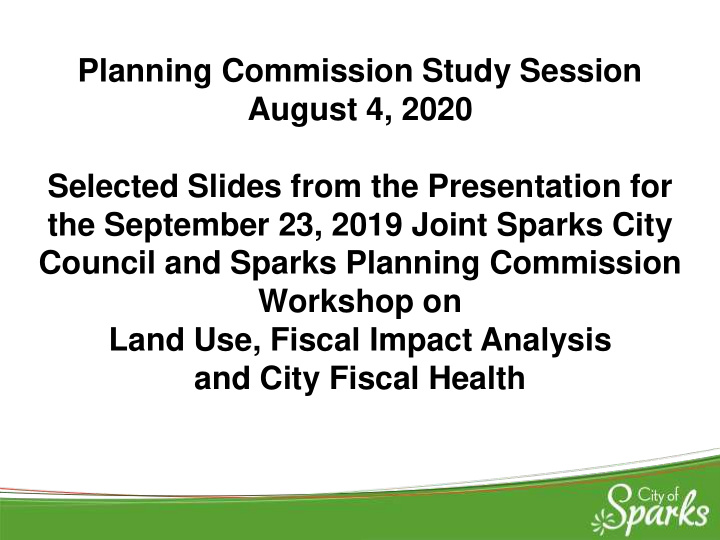



Planning Commission Study Session August 4, 2020 Selected Slides from the Presentation for the September 23, 2019 Joint Sparks City Council and Sparks Planning Commission Workshop on Land Use, Fiscal Impact Analysis and City Fiscal Health
Workshop Agenda ➢ Project background and purpose ➢ Consultant (Economic & Planning Systems, Inc.) work program ➢ City of Sparks General and Road Funds overview ➢ Fiscal impact analysis: objective, model, & policy considerations ➢ Long term fiscal health analysis ➢ Discussion and possible action
Long Term Fiscal Health Analysis - Intro Purpose – address the following questions: ➢ How will build-out of Sparks, based on the uses adopted in the City’s Comprehensive Plan, impact the City’s long -term fiscal health? ➢ How would changes to the Comprehensive Plan erode or improve fiscal health? ➢ What guidance can the analysis provide to City staff, the Planning Commission and the City Council regarding land use entitlement requests?
Forecasts Population and Land Demand for Housing Employment and Land Demand for Non-Residential Development
Forecast - Population Truckee Meadows Regional Planning Agency (TMRPA) Consensus Forecast for period through 2038: ➢ Washoe County forecast to grow by 106,823 residents (1% a year) to 558,746. ➢ Sparks forecast to add 23,180 residents (1% a year) to 120,108.
Forecast – Housing Demand for Land Methodology: ➢ TMRPA 2016 Housing Study defines 5 types of housing. EPS forecast demand for Sparks, by type, based on building permit trends. ➢ Density ranges for each housing type in TMRPA study used by EPS to translate housing unit demand to land demand for each housing type.
Residential Demand by Type, Sparks, 2017 to 2038 Housing Type # of Units # of Acres Low-Density Single Family (SF) 244 163 (1.5 DU/Acre) Moderate-Density SF (4.5 DU/Acre) 5,490 1,220 High-Density SF / 3,050 305 Low-Density Multi-Family (MF) (10 DU/Acre) Moderate Density MF (25 DU/Acre) 2,440 98 High-Density MF (50 DU/Acre) 976 20 Totals 12,200 1,805
Forecast – Non-Residential Development Methodology: ➢ TMRPA, State Demographer, and private 3 rd party forecasts used to project overall and industry-specific employment growth in Reno-Sparks MSA. ➢ Basis is Consensus Forecast that Washoe County will add 94,333 “establishment based” jobs (1.4% a year). ➢ Estimated 75K jobs will generate demand for new buildings in region by 2038
Forecast – Non-Residential Development Next, EPS: ➢ Projected employment by industry from 2018 – 2038. ➢ Aggregated jobs by industry to the three categories of office, industrial and retail uses. ➢ Applied square feet by employee and floor area ratio factors to convert employment forecast to demand for new building space and land.
Forecast – Non-Residential Development EPS then took their regional forecasts and estimated: ➢ Capture rates for Sparks of regional office, industrial and retail development. ➢ Amount of building space and land, by type, forecast to be developed in Sparks.
Non-Residential Demand by Type of Use Sparks, 2018 to 2038 Type of Non-Residential Use Square Feet # of Acres Office 402,337 31 Industrial 7,112,479 816 Retail 1,556,436 114 Totals 9,071,252 961
Sparks Non-Residential Development Capture Rates 2018 to 2038 Existing Space - Square Feet* Sparks Type of Use Washoe & Storey Sparks Capture Rates Office 16,277,730 1,319,583 10% Industrial 90,996,937 28,507,860 30% Retail 25,885,180 6,093,398 25% Totals 133,159,847 35,920,841 25% * Square footage figures are for the 4 th quarter of 2018; source is CoStar .
Demand Versus Capacity of Land
Demand Versus Capacity of Land Sparks has sufficient land to accommodate forecasted growth in aggregate. ➢ Residential demand forecast is for 1,805 acres; 2,502 acres available. ➢ Non-residential demand forecast is for 961 acres; 1,345 acres are available.
Demand Versus Capacity of Land There are two sub-categories where demand is projected to exceed land capacity: ➢ Moderate density single family residential – forecasted demand is for 1,220 acres while there are 939 acres of capacity. ➢ Industrial – forecasted demand is for 7.1M square feet while there are 4.8M square feet of capacity.
Demand Versus Capacity of Land for Non-Residential Uses by Type (in Acres) Sparks, 2018 to 2038 Type of Use Demand Capacity % Demand of Capacity Office 31 540 6% Industrial 816 426 192% Retail 114 379 30% Totals 961 1,345 71%
Conclusions 4. A balance between employment and residential growth is needed to support fiscal health. ➢ Each type of land use has varying impacts on the General and Road Funds. o Employment uses (office and industrial) typically generate a positive impact to the City that can offset negative fiscal impacts from other uses.
Conclusions 5. Employment growth, either office-oriented or industrial-oriented, generates relatively same fiscal benefits. This finding, based on the Increased Business Park alternative (Sparks captures more office), illustrates that at suburban densities, these two uses are relatively interchangeable from a fiscal perspective.
Conclusions 6. Retail uses generally have a more negative impact on the General Fund than office or industrial uses due to increase of traffic and police calls these uses generate. 7. The City’s current land use plan adequately balances growth but City should strive to ensure employment uses are attracted to planned sites at the same rate as residential uses.
Conclusions 8. Sparks lacks industrial lands ➢ This can impact future fiscal health if either increased capacity is not created or alternative employment uses are not attracted.
Discussion – August 4, 2020 Application of the Long-Term Fiscal Health Analysis findings includes: ➢ Future modification of Policy MG4 as part of 2020 Comprehensive Plan amendments ➢ Ongoing use of findings in analysis of entitlement requests
Recommend
More recommend